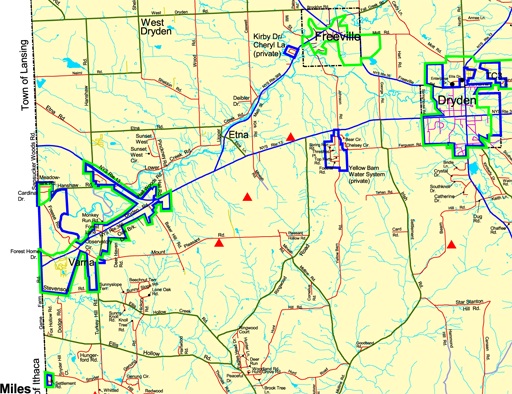August 30, 2010
The curse of water and sewer
When I was buying my house, there was a small problem. The mortgage folks wanted a water test, and we hadn't done one. Why hadn't we done one? Because although the house has a well, it only goes to the garden faucets these days. It's on Bolton Point water, and connected to the sewer system as well. That got us through that hoop, though it also took a few years before I could convince my insurance company that there was a fire hydrant just down the way. Apparently water and sewer are largely invisible, even to the people who track infrastructure. I didn't think hard about it at the time, though maybe I should have.
You can, however, see it by searching for fire hydrants, pumping stations, and manholes, or by tracking down maps like the one in the 2005 Comprehensive Plan:

Infrastructure in Dryden (Click to enlarge and see the whole town).
There are only two large areas with both water and sewer in the Town. The first follows 366 from the Ithaca line out to some of the Route 13 area, and then goes east from there along 13, Lower Creek, and Hanshaw Roads. The other is the Village of Dryden and some of its customers. Some areas along Freese Road have water but not sewer, and there's a tiny area south of Snyder Hill Road which has both water and sewer.
When I first moved in, I was delighted to have tap water that tasted better than the sulfury garden water, and not to have to worry about a septic tank and leach field. Yes, the taxes are significant - no question! - but maintaining wells and septic systems isn't a free lunch either.
I was surprised by the rush to reject a water district in Ellis Hollow in 2006, though probably less surprised by the rejection than that it had come up at all. Development follows infrastructure, after all, and Ellis Hollow is also even more spread out than the expensive Turkey Hill water and sewer district area. It just wasn't going to happen.
The Comprehensive Plan and the Draft Zoning both push hard on concentrating development in areas that already have infrastructure. From a planning perspective this makes sense, as septic systems are hazardous in densely populated areas, infrastructure is expensive, concentration allows the creation of neighborhoods, and in some ways can reduce transportation costs.
From a resident's perspective, though, this is not much fun. Most residents have no plans to build even four units, much less ten units, on their property, yet pay lots of taxes for the privilege of letting someone build developments they might not even support. Many of these taxpayers have lots or frontage too small to let them take advantage of such possibilities, even if they see them as an opportunity.
The result is that living in an area with water and sewer districts - but no local village - is a risky proposition. Developers are steered to your neighborhood by default, and because that neighborhood contains only around a tenth of the residents in the town, you lack political clout to say no.
The two most common reasons I've heard for why people live in Dryden instead in denser areas are that they want to live in the country and it's cheaper. The infrastructure doesn't help on either count. (Community is another part, though generally folks have to live here a while to see that, and I don't think I can make a plausible case that this infrastructure helps much on that count.)
The existing western area covered by the water and sewer districts is pretty much stuck, unless it can find the wherewithal to form a village and take control of its own destiny, as the Village of Dryden certainly has. In the meantime, we'll be forced to keep a paranoid eye on the Town of Dryden - and I'm happy to report that lots of Varna residents have indeed been showing up to meetings.
The zoning also contains Optional Neighborhood District Overlay areas around Etna and south and east of the Village of Dryden. Perhaps recognizing that cranking up the allowed density to the levels permitted by the hamlet and commercial zoning (10 dwellings/acre) would ensure that those areas avoid ever getting water and sewer infrastructure, the maximum density there is set to six dwellings per acre.
My strong advice to those areas, though, would be to avoid water and sewer unless there's a catastrophic need or you can form or join a village and localize land use decisions. The current planning model may make sense on a macro scale, but it has the really nasty side effect of inducing paranoia about your neighbors once you've read what's allowed in areas with infrastructure, and "in-between densities" are worth worrying about.
Perhaps New York State's efforts to reduce the overall number of municipal governments might better be served by trying to consolidate the piles of water, sewer, and lighting districts into villages than by encouraging villages to dissolve.
Posted by simon at August 30, 2010 8:45 PM in Ellis Hollow , Varna , planning and zoning , water and sewerNote on photos